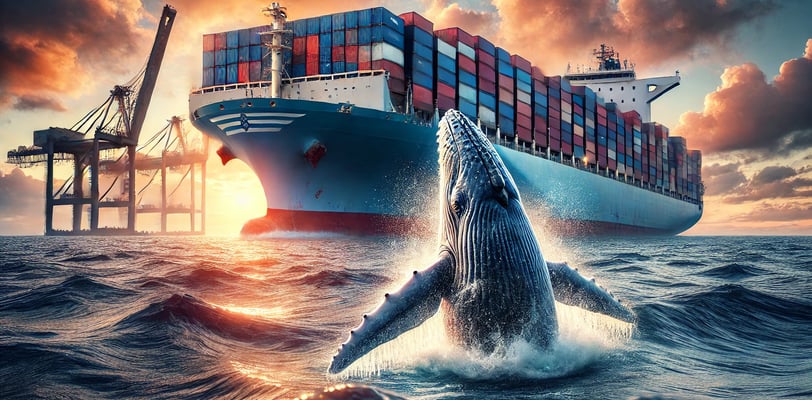The Overlapping Routes of Cargo Ships and Cetaceans: A Conservation Crisis
The Overlapping Routes of Cargo Ships and Cetaceans: A Conservation Crisis. The intersection of large-scale maritime commerce and the natural movement of marine megafauna highlights a crucial and often invisible conflict in ocean conservation.
SCIENCE
Camapa Editorial
12/7/20243 min read


In recent years, the collision between human maritime activity and marine life has become an urgent conservation concern. One of the most significant threats to large marine mammals, particularly whales, arises from the interaction between their migratory routes and the heavily trafficked paths of commercial cargo vessels. Understanding the geographic overlap of these two systems is critical to mitigating the adverse impacts on marine biodiversity.
Global Trade and Maritime Traffic: A Growing Problem
Global trade is predominantly reliant on maritime transport, with cargo vessels moving across the world's oceans and seas to connect major economic centers. The increased demand for goods, coupled with a rapidly expanding maritime industry, has resulted in a marked increase in both the number and size of ships crossing international waters. This maritime traffic, essential for global commerce, inadvertently overlaps with the natural habitats of cetaceans, whose migrations are dictated by centuries of evolutionary behavior tied to feeding, breeding, and socializing patterns.
Geographical Overlap and Hotspots of Conflict
Recent studies using satellite tracking and modeling have shown that approximately 91.5% of the known migration areas of whale populations coincide with the major global shipping lanes. Key hotspots include the North American West Coast, the Strait of Gibraltar, the coastal waters near China, as well as specific regions in the southern Indian Ocean. In these areas, whale species such as blue whales (Balaenoptera musculus), humpback whales (Megaptera novaeangliae), and fin whales (Balaenoptera physalus) frequently face threats from large vessels that may not detect their presence in time to avoid collisions.
The Consequences of Ship Strikes
Ship strikes are considered one of the leading causes of injury and death in large cetaceans, particularly in areas where vessel traffic density is high. When a collision occurs, it often results in either fatal injuries or severe trauma that significantly hampers the whale's ability to survive and reproduce. The immense speed and mass of modern cargo ships, coupled with the difficulty of detecting these large mammals at the surface, leave very little opportunity for avoidance maneuvers.
Moreover, noise pollution created by vessels interferes with the whales' sophisticated echolocation and communication systems. Whales rely heavily on sound to communicate, navigate, and locate prey. The acoustic disturbance from engines and propellers can lead to displacement from feeding grounds and the interruption of social behaviors that are crucial for survival.
Mitigation Strategies and Conservation Measures
Addressing the overlap between shipping routes and cetacean migration paths requires a combination of mitigation strategies and policy measures. One effective approach has been the implementation of Marine Protected Areas (MPAs), which restrict the movement of vessels in regions critical to marine mammal activities, such as feeding or breeding grounds. Speed restrictions in identified whale habitats have also been proven to significantly reduce the likelihood of fatal collisions, as slower-moving ships give whales more time to detect and avoid them.
A more advanced technological solution involves real-time whale detection systems. These technologies include acoustic monitoring buoys and whale-tracking networks that provide up-to-date information on whale locations, allowing vessels to adjust their routes or speeds accordingly. Such innovations, if widely adopted, could dramatically decrease ship strikes and contribute to the coexistence of maritime activity and marine biodiversity.
The Way Forward
To ensure the safety of cetacean populations, further international cooperation is necessary. Coastal nations and international maritime organizations must collaborate to enforce shipping regulations, speed limits, and provide alternative routing solutions. Additionally, the shipping industry can play a proactive role by supporting scientific initiatives, funding conservation technologies, and adjusting their operational procedures based on new research findings.
The intersection of large-scale maritime commerce and the natural movement of marine megafauna highlights a crucial and often invisible conflict in ocean conservation. Finding the balance between global trade needs and environmental protection is a complex challenge, but one that can be addressed with scientific innovation, international cooperation, and a willingness from industries to adopt more sustainable practices. By integrating these efforts, we can strive towards reducing the risk of ship strikes and preserving the natural heritage of our oceans.
Camapa Editorial
camapaeditorial@gmail.com
© 2024. All rights reserved.
Our mission at Camapa Editorial is to explore, analyze, and present insights within these fields in a way that both educates and inspires further inquiry. Whether delving into groundbreaking scientific discoveries, examining the intricacies of athletic performance and emerging sports, or exploring the multifaceted world of entertainment, Camapa Editorial aims to be a trusted guide in your journey of learning and exploration.
